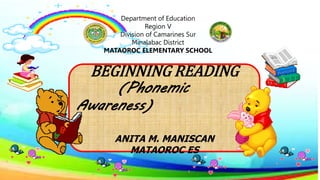
Beginning reading - Phonological awareness - Copy.pptx
- 1. BEGINNING READING (Phonemic Awareness) ANITA M. MANISCAN MATAOROC ES Department of Education Region V Division of Camarines Sur Minalabac District MATAOROC ELEMENTARY SCHOOL
- 2. Phonemic awareness is the ability to hear, identify, move or change sounds, called phonemes, in spoken words. Phonemic awareness is an important basic skill that gets students ready to develop into readers. Phonemic awareness is usually taught during kindergarten and beginning first grade. What is Phonemic Awareness?
- 3. » Phonemic awareness is a critical skill for learning to read an alphabetically written language. Yet a fair amount of confusion, especially among educators, persists about what this skill is and why it is so important.
- 4. Phonemic Awareness is important ... It requires readers to notice how letters represent sounds. It primes readers for print. It gives readers a way to approach sounding out and reading new words. It helps readers understand the alphabetic principle (that the letters in words are systematically represented by sounds).
- 5. Recognizing that words are made up of discrete sounds, and that those sounds can be changed, is essential for success in learning to read and spell. Similarly, understanding the connection that words are made up of phonemes
- 6. and that phonemes are represented by graphemes is a vital skill for understanding print. Being able to take words apart, put them together again and adapt them into a new word (or even a nonsense word!) is a fundamental skill.
- 7. Children can demonstrate phonemic awareness in several ways, including: recognizing which words in a set of words begin with the same sound. isolating and saying the first or last sound in a word. combining, or blending the separate sounds in a word to say the word. ... breaking, or segmenting a word into its separate sounds.
- 8. When we explain to a child that the first sound in bug is "buh," what we are actually pronouncing is neither abstract (for abstract things are by definition unpronounceable) nor something related to a single phoneme.
- 9. In fact, what we are saying is a syllable, one that has two phonemes underlying it. Thus, one difficulty in developing phonemic awareness is that it is not possible to explicitly state to the child what she must become aware of, rather we can only lead her to try to induce for herself what must be acquired.
- 10. How Does Phonemic Awareness Relate to Reading and Spelling?
- 11. Phonemic awareness: the ability to identify and manipulate the distinct individual sounds in spoken words. Phonics: the ability to decode words using knowledge of letter- sound relationships.
- 12. Fluency: reading with speed and accuracy. Being able to read automatically, accurately and quickly is an important skill when learning to read.
- 13. Vocabulary: knowing the meaning of a wide variety of words and the structure of written language. Comprehension: understanding the meaning and intent of the text.
- 14. Things to remember when teaching phonemic awareness are……
- 15. It is important for children to hear lots of modelling of these skills, before being asked to do it themselves.
- 16. Most children learn to orally blend words before they can orally segment, and when learning to segment, they may not hear and say all the phonemes in a word. For example, for the word cup, they may say “c-p”.
- 17. Continually working on phonemic awareness and other phonological activities alongside teaching phonics is important
- 18. Stick to cvc words (consonant vowel consonant) at first, but remember that these don’t just include words like hat and van, but also words like sheep (sh-ee- p) and chick (ch-i-ck).
- 19. Activities should be enjoyable and engaging; children should want to do the activity again. Remember, creating a positive attitude towards reading and writing is essential to build on these skills.
- 20. Factors that can Affect a Child’s Phonemic Awareness
- 21. There are a number of factors that can affect a child’s phonemic awareness. Firstly, check that the child is pronouncing the phonemes correctly. There is a tendency for people to put an ‘uh’ sound on some phonemes, for example, “cuh” rather than “c” and “duh” rather than “d”.
- 22. This leads to a struggle to blend phonemes: for example with the word cat, instead of blending “c-a-t”, they may attempt “cuh- ahh-tuh”, making “cuhahhtuh”, which can cause confusion as it’s not a word.
- 23. Hearing difficulties: most children have a hearing test in their first year of school, though temporary hearing loss following a cold and glue ear are common Speech and language difficulties: a child may have difficulty pronouncing sounds and words correctly.
- 24. Dyslexia: dyslexia is a learning difficulty which primarily affects accurate and fluent reading and spelling. One the characteristics of dyslexia is poor phonological awareness, and children with dyslexia will often need extra support.
- 25. Autism: some children with autism have speech sound difficulties or auditory processing disorders. Many children with autism are visual thinkers, and find abstract concepts like oral blending and segmenting difficult to grasp. They are more likely to benefit from using concrete objects, like magnetic letters. Remember to avoid long verbal explanations.
- 26. Working memory: working memory is the ability to hold and manipulate information in the mind for a short period of time.